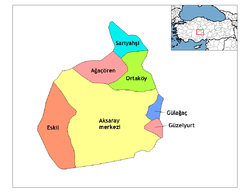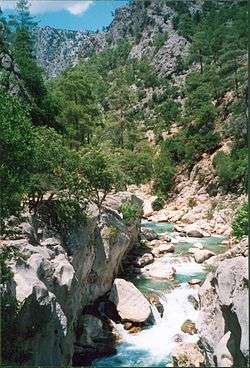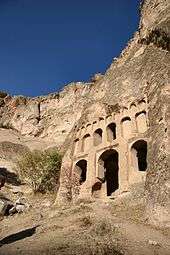Güzelyurt
Güzelyurt, formerly Gelveri (Cappadocian Greek: Karvali[3]), is a town and district of Aksaray Province in the Central Anatolia region of Turkey, at a distance of 45 km (28 mi) from the city of Aksaray. According to 2000 census, population of the district is 16,836 of which 3,775 live in the town of Güzelyurt.[4][5] The district covers an area of 322 km2 (124 sq mi),[6] and the average elevation is 1,485 m (4,872 ft).
Güzelyurt | |
|---|---|
District | |
 | |
 Location of Güzelyurt within Turkey. | |
| Coordinates: 38°17′N 34°22′E | |
| Country | |
| Region | Central Anatolia |
| Province | Aksaray |
| Government | |
| • Governor | Ramazan Yıldırım |
| • Mayor | Kudret Özeş (AKP) |
| Area | |
| • District | 322.25 km2 (124.42 sq mi) |
| Elevation | 1,485 m (4,872 ft) |
| Population (2012)[2] | |
| • Urban | 2,672 |
| • District | 12,527 |
| • District density | 39/km2 (100/sq mi) |
| Time zone | UTC+2 (EET) |
| • Summer (DST) | UTC+3 (EEST) |
| Postal code | 68xxx |
| Area code(s) | 0382 |
| Licence plate | 68 |
| Website | www.guzelyurt.gov.tr |
This area is part of the ancient region of Cappadocia, near the Ihlara Valley.
History
Cappadocia has an important place in the history of Christianity and Gregory of Nazianzus lived in the area. A historically large native Cappadocian Greek population existed in the area until the 1924 population exchange (see Cappadocian Greeks), when they were replaced with the Turks from Thessaloniki and Kavala. The monastery, churches, refuge caves, and mansions attest to the culture of the indigenous Cappadocian Greek population.[7]
Places of interest
Güzelyurt is known for having three underground cities and over 50 churches carved into the rocky volcanic landscape including:
- Ihlara Valley
- Monastery Valley, "Manastır Vadisi"
- Fairy Chimneys, "Peri Bacaları"
- Antique Greek houses
- Ahmatlı Church
- St. Anargiros Church, "Sivişli Kilise"
- Koç Church
- Cathedral of Selime
- The rock monastery of Selime, one of the largest religious buildings in Cappadocia.
- Red Church, "Kızıl Kilise" - a 5th or 6th century church in the village of Sivrihisar
- Analipsis Church, "Yüksek Kilise" (High Church) on the hill of Analipsis. Stone age relics have been found nearby.
- St. Gregorius Church, "Kilise Cami" - another rock-hewn church, in use today as a mosque
- St. Spyridon Church, "Kızıl Kilise" - another red church in the vicinity of Güzelyurt.
Other places of interest include:
- The tomb of Selime Sultan in the village of Selime.
- Linseed House, "Bezirhane" in the village of Belisırma.
- Ziga thermal springs, "Ziga kaplıcaları" is located in the village of Yaprakhisar very close to Ihlara Valley.
- An underground city is situated in Gaziemir village of Güzelyurt.[8]
Image gallery

Ihlara Valley 
St. Gregorius Church 
A church in Ihlara Valley
See also
Notes
- "Area of regions (including lakes), km²". Regional Statistics Database. Turkish Statistical Institute. 2002. Retrieved 2013-03-05.
- "Population of province/district centers and towns/villages by districts - 2012". Address Based Population Registration System (ABPRS) Database. Turkish Statistical Institute. Retrieved 2013-02-27.
- Oberheu, Susanne. Wadenpohl, Michael (2010). Cappadocia. BoD. pp. 270–1. ISBN 978-3-8391-5661-2.
On May 1st, 1923, the agreement on the exchange of the Turkish and Greek minorities in both countries was published. A shock went through the ranks of the people affected – on both sides. Within a few months they had to pack their belongings and ship them or even sell them. They were to leave their homes, which had also been their great-grandfathers’ homes, they were to give up their holy places and leave the graves of their ancestors to an uncertain fate. In Cappadocia, the villages of Mustafapasa, Urgup, Guzelyurt and Nevsehir were the ones affected most by this rule. Often more than half the population of a village had to leave the country, so that those places were hardly able to survive…The Greeks form Cappadocia were taken to Mersin on the coast in order to be shipped to Greece from there. But they had to leave the remaining part of their belongings behind in the harbor. They were actually promised that everything would be sent after them later, but corrupt officials and numberless thieves looted the crammed storehouses, so that after a few months only a fraction of the goods or even nothing at all arrived at their new home….Today the old houses of the Greek people are the only testimony that reminds us of them in Cappadocia. But these silent witnesses are in danger, too. Only a few families can afford the maintenance of those buildings….
CS1 maint: multiple names: authors list (link) - Turkish Statistical Institute. "Census 2000, Key statistics for urban areas of Turkey" (XLS) (in Turkish). Retrieved 2008-04-02.
- GeoHive. "Statistical information on Turkey's administrative units". Retrieved 2008-04-02.
- Statoids. "Statistical information on districts of Turkey". Retrieved 2008-04-21.
- Güzelyurt becomes a touristic hub. AKSARAY - Anatolia News Agency. July 17, 2012.
In the town of Güzelyurt in Aksaray Province in the Central Anatolian region of Turkey, 250-year-old arched stone mansions have been transformed into boutique hotels to serve tourists coming to discover the area’s cultural and historical treasures. The town is an important part of the historical Cappadocia region…Much of the previously large Greek population in Güzelyurt vanished with the population exchange of the 1920s. "With the population exchange in 1924, Greeks and Turks exchanged places. Before the population exchange, rich Greeks dealing with trade in Istanbul had historical mansions in Güzelyurt," Özeş said. Some houses in the town date back 250 years and a few 100-year-old historical houses also exist, according to Özeş. "They have extremely thick walls. The height of the arches is nearly four to five meters. Each of the houses is a work of art creating an authentic environment."
- Governorship of Aksaray, Turkey. "Underground cities in Aksaray". Archived from the original on March 7, 2008. Retrieved 2008-04-02.
References
- Falling Rain Genomics, Inc. "Geographical information on Güzelyurt, Turkey". Retrieved 2008-04-02.
- Turkish Ministry of Culture and Tourism. "General information on Güzelyurt, Aksaray" (in Turkish). Archived from the original on January 14, 2016. Retrieved 2008-04-02.
- Governorship of Güzelyurt, Aksaray. "Touristic areas in Güzelyurt". Archived from the original on June 19, 2008. Retrieved 2008-04-02.
External links
| Wikimedia Commons has media related to Güzelyurt. |
- District governor's official website (in Turkish and English)
- District municipality's official website (in Turkish)
- Aksaray governor's office (in Turkish, English, and French)